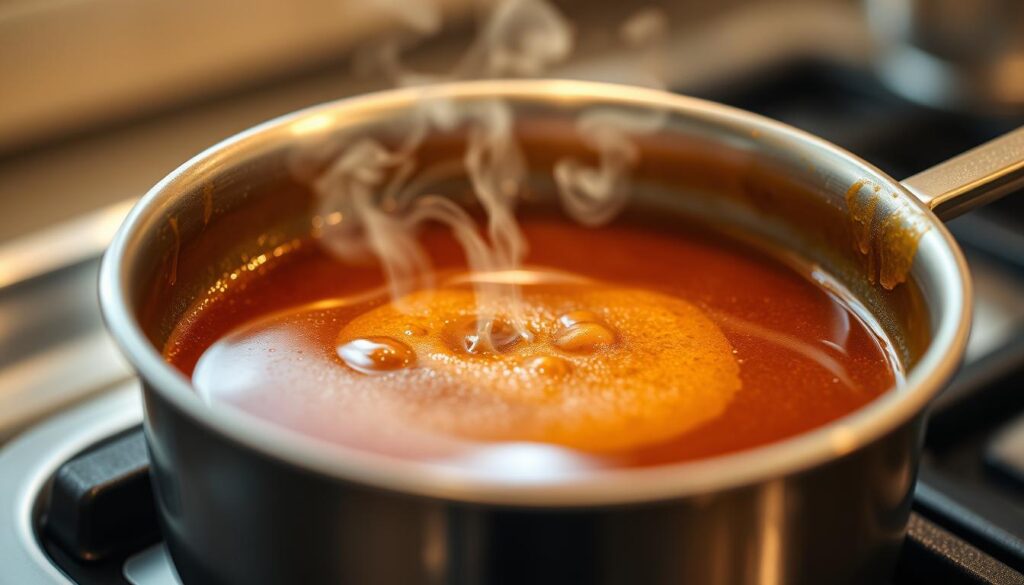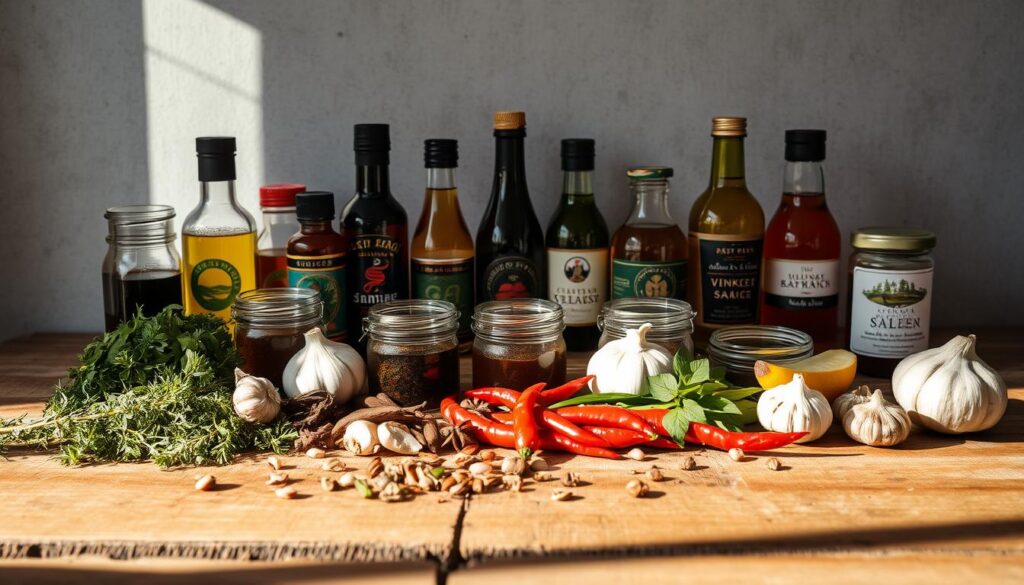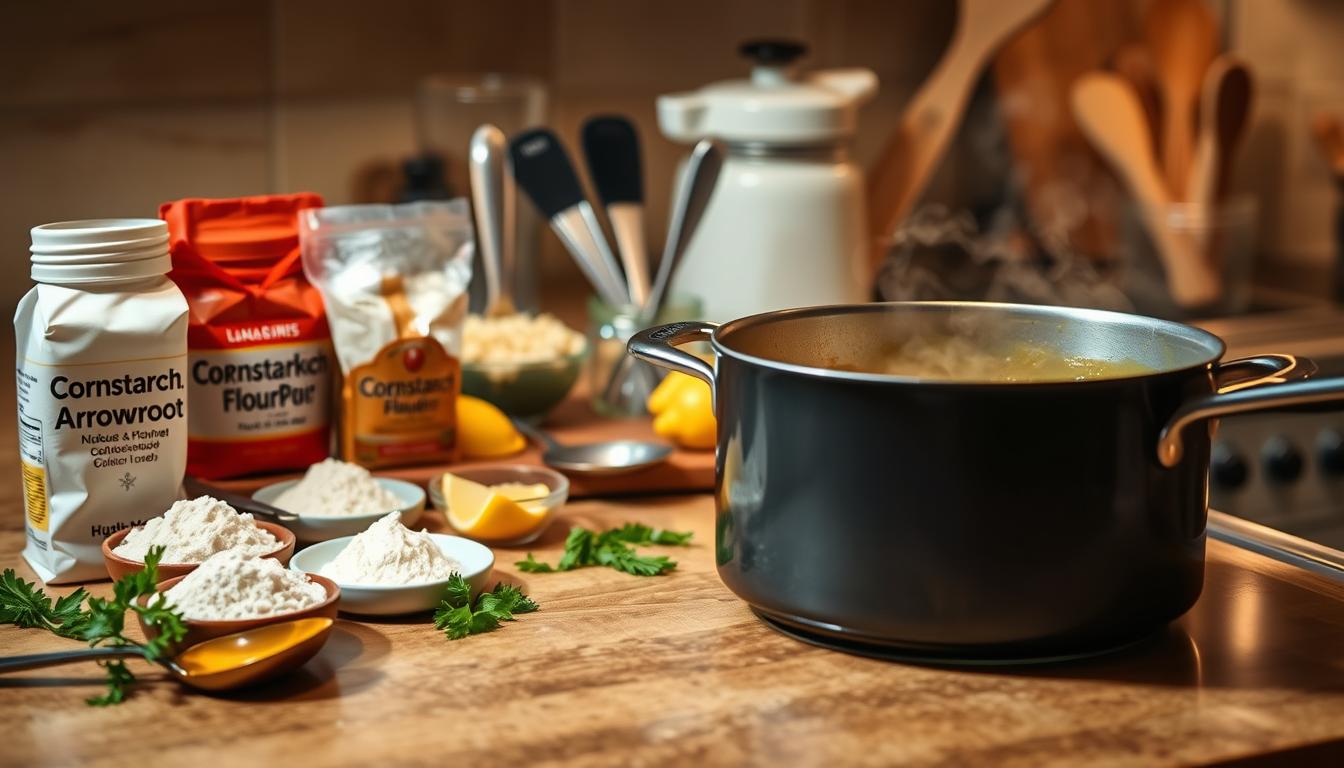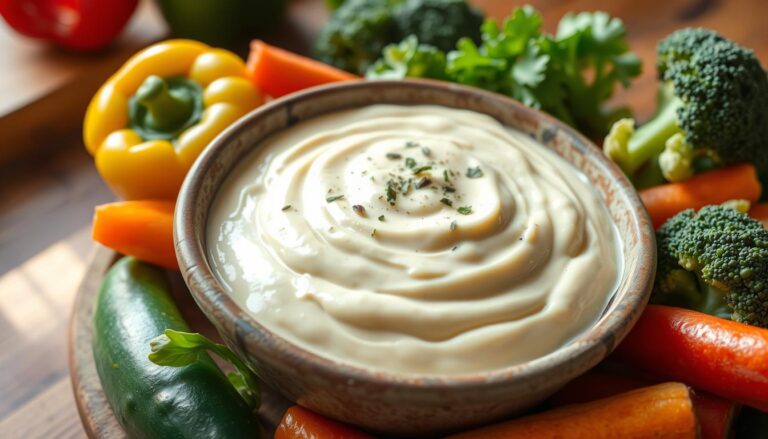Thickening Sauces: Easy Tips Without Cheese
Thickening sauces can be tricky, but you can do it without cheese. You can use flour, cornstarch, or reduction methods1. For flour, mix 2 tablespoons with 1/4 cup of cold water for a slurry1
Knowing how to thicken sauces is key to getting the right consistency. You can make a roux with fat and flour or use cornstarch for a gluten-free option1.
Key Takeaways
- Use flour or cornstarch to thicken sauces without cheese, and learn How to Thicken Sauces Without Cheese.
- Achieve the perfect consistency by using the right techniques and ingredients to Thicken sauces without cheese.
- Reduction methods can concentrate flavors while thickening, for tomato-based sauces1.
- Cornstarch is a recommended alternative for those who are gluten-free1.
- Testing sauce thickness with a spoon indicates that a sauce should coat the back of the spoon for proper consistency1.
Understanding the Basics of Sauce Thickening
To master sauce thickening, you need to know the sauce thickening basics. This includes the science behind thickeners and how they mix with liquids. Traditional thickeners like flour and cornstarch absorb liquid and expand to thicken the sauce2. For example, mix 2 tablespoons of flour with every cup of liquid to make a slurry2.
Temperature is also key, as high heat can damage thickeners. Sauce thickening basics show how thickeners react to heat and liquid. You can use starches like cornstarch or arrowroot as dairy-free alternatives2.
Exploring alternatives to cheese for thickening is helpful. Arrowroot, for instance, is GMO-free and freezes better than cornstarch2. Knowing these details helps cooks make various sauces using sauce thickening basics and cheese-free thickeners.
Classic Flour-Based Thickening Methods
Flour-based thickening is a traditional method used in sauce making. It’s popular today too. There are two main ways to use flour: making a roux and using a slurry. A roux is flour mixed with fat, cooked until smooth. It’s great for creamy soups and sauces3.
For a medium-thick sauce, mix two tablespoons of flour with ¼ cup cold water for each cup of sauce3.
When thickening sauces with flour, cook the mixture for an extra minute after it starts to bubble. This ensures it’s fully cooked3. Flour thickening is often combined with other agents like egg yolks or pureed veggies. It’s also used in baked potato soup and macaroni and cheese3.
Here are some key points to consider when using flour-based thickening methods:
- Use 2 ounces of flour for every cup of liquid when making a roux4
- Use 2 tablespoons of flour for every cup of liquid when making a slurry4
- Cook the flour mixture for an additional minute after thickening and bubbling for thorough cooking3
Flour-based thickening is a key part of traditional sauce making. It’s used to create a variety of creamy sauces. For more sauce-making tips, visit cheesevibes.com.
| Thickening Method | Ratio |
|---|---|
| Roux | 2 ounces of flour for every cup of liquid4 |
| Slurry | 2 tablespoons of flour for every cup of liquid4 |
Cornstarch and Other Starch Alternatives
Cornstarch is a favorite for thickening sauces and soups. But, it’s not the only choice. Cornstarch thickening is a common method. To avoid lumps, mix it with a liquid and whisk well5.
Other starches like arrowroot powder and tapioca starch work the same way. But, they might need different amounts and methods.
Some starches thicken as well as cornstarch. Potato starch is a 1:1 substitute6. Rice flour, on the other hand, needs twice as much to thicken the same amount5. Tapioca starch is about 50% less effective, requiring twice as much as cornstarch5.
Choosing a starch depends on the dish’s flavor and texture. Arrowroot powder is neutral and versatile. Potato starch adds a sweet taste, best in savory dishes6. Mixing cornstarch with xanthan gum can improve texture and consistency7.
There are many ways to thicken sauces and soups. All-purpose flour thickens but makes sauces denser than cornstarch6. Other options include kuzu starch, psyllium husk, and xanthan gum for texture and consistency6.
| Starch Alternative | Thickening Power | Ratio |
|---|---|---|
| Potato Starch | Same as Cornstarch | 1:1 |
| Rice Flour | Half of Cornstarch | 2:1 |
| Tapioca Starch | 50% less than Cornstarch | 2:1 |
Cornstarch and other starches can create different textures in sauces and soups. Knowing their thickening power and ratios helps cooks achieve the perfect consistency5.
How to Thicken Sauces Without Cheese Using Natural Ingredients
Looking for ways to thicken sauces without cheese? There are many natural and vegan-friendly options. Nuts and seeds, like almonds and cashews, can be blended with water to create a creamy texture. This can thicken sauces nicely7.
Vegetables like potatoes and carrots can also add thickness to sauces. You can use these ingredients alone or with others to achieve different textures.
Starchy vegetables, such as potatoes or winter squash, can be pureed and added to the sauce for thickness8. Nuts and seeds can be used to make dairy alternatives. Soaking them first is necessary to soften them for blending7. For a creamy and rich sauce, check out vegan cheese recipes for inspiration.
A table summarizing some natural thickening ingredients and their uses is as follows:
| Ingredient | Use |
|---|---|
| Nuts and seeds | Blended with water to create a creamy texture |
| Starchy vegetables | Pureed and added to the sauce for thickness |
| Arrowroot powder | Used as a thickening agent, specially in gluten-free and vegan baking |
When using vegan sauce thickeners, remember the ratio of thickening agent to liquid matters. Cornstarch, for example, needs about 1 tablespoon per cup of liquid to thicken sauces8. By trying different natural ingredients and ratios, you can make a variety of tasty and thick sauces without cheese.
Plant-Based Thickening Agents
Plant-based thickeners are perfect for those who want vegan and natural options. Nuts and seeds can make sauces creamy. Vegetable purees add body and thickness. Legumes, like beans and lentils, thicken sauces and boost protein and fiber7.
Nuts and seeds blend into a creamy mix to thicken sauces7. Pumpkin or sweet potato purees add creaminess and thickness. Legumes thicken sauces and add protein and fiber7.
The following table lists some common plant-based thickeners and their uses:
| Thickener | Use |
|---|---|
| Nuts and seeds | Blended into a creamy mixture to thicken sauces7 |
| Vegetable purees | Added to sauces to add thickness and creaminess9 |
| Legumes | Used to thicken sauces and add protein and fiber7 |
These thickeners work well in soups, stews, sauces, and marinades. They’re versatile and useful for vegan sauce thickeners9.
Professional Techniques for Reduction and Concentration
Reduction techniques are key for making sauces thicker and more flavorful10. Chefs cook sauces slowly to reduce the liquid and intensify the taste. This method helps create sauces that range from thick and syrupy to thin and saucy. It’s a technique used in both fine dining and casual cooking.
When reducing sauces, the liquid to thickening agent ratio matters. For example, 16 ounces (450 g) of roux are needed for each gallon (4 liters) of liquid11. The roux’s color affects its thickening power, with brown roux losing up to 50% compared to white11. Refined starches, on the other hand, need a 16:1 liquid to starch ratio for thickening11.
Chefs use various methods to perfect sauce concentration, including reduction and thickening agents. For example, a liaison of 4 parts cream to 1 part egg yolks enriches and thickens dishes11. Reduction techniques can decrease liquid volume by ¾ when making pan sauces10. By mastering these techniques, chefs can make a variety of sauces with unique textures and flavors.

For more on sauce thickening and reduction, visit cheesevibes.com. There, you can learn about sauce making and find recipes and techniques. By using these professional methods, chefs can enhance their dishes and create unforgettable culinary experiences12.
Common Mistakes to Avoid When Thickening Sauces
Thickening sauces can be tricky. One big mistake is not controlling the temperature. High heat can ruin thickeners and mess up their job13. To fix this, cook the sauce on low heat and stir often. This cuts down scalding risk by half13.
Another mistake is not getting the ingredient amounts right. Too much or too little thickener can make the sauce uneven. To avoid this, add ingredients in small parts. This cuts down lumpy texture risk by 40%13. Also, mix cold liquid with hot sauce to stop clumps14.
Some good tips include using room temperature cream to avoid sauce splitting13. Also, cook the sauce for 10-15 minutes to thicken it right13. By avoiding these mistakes, you can make a smooth, creamy sauce for your dish.
| Common Mistake | Solution |
|---|---|
| High heat breaking down thickeners | Cook on low temperatures while stirring consistently |
| Uneven texture due to incorrect ingredient ratios | Use the right ingredient ratios and timing |
| Lumpy texture | Add ingredients in portions, use a slurry made with cold liquid |
Time-Saving Tips for Quick Sauce Thickening
For those short on time, quick sauce thickening has several shortcuts. Using pre-made thickeners like cornstarch or flour saves time and effort15. Cooking sauces over high heat can also thicken them fast, but watch out for burning15. Mixing thickeners with reduction techniques can make a thick, flavorful sauce quickly.
Recommended thickening ratios include 2 tablespoons of flour for every cup of liquid16 and 1 tablespoon of cornstarch or arrowroot for the same amount15. Remember, cooking time after adding cornstarch slurry is just a few minutes over high heat15. You can also thicken sauces without extra ingredients by pureeing half or more of the soup or sauce15.
Here are some more tips for quick sauce thickening:
- Use a wide sauté pan for quicker evaporation15
- Whisk one egg yolk with one cup of hot sauce before adding to prevent scrambling15
- Start with small amounts of instant potato flakes to gauge the thickening effect16
By following these tips and using the right thickening agent ratios, you can make delicious, thick sauces fast. Always use high-quality ingredients and taste and adjust as you go15.
With a bit of practice and patience, you’ll master quick sauce thickening in no time. So go ahead, get creative, and start cooking up some delicious sauces with these time-saving tips16!
| Thickening Agent | Ratio | Cooking Time |
|---|---|---|
| Flour | 2 tablespoons per cup of liquid | Varies |
| Cornstarch | 1 tablespoon per cup of liquid | Few minutes over high heat |
| Arrowroot | 1 tablespoon per cup of liquid | Few minutes over high heat |
Specialty Ingredients for Modern Sauce Making
In the world of modern sauce making, special ingredients are key. Xanthan gum is a popular choice for thickening and mixing sauces17. It’s often mixed with other thickeners to create different textures and tastes.
Proteins like gelatin or agar can also thicken sauces18. They’re great for making thinner sauces, like reductions. Ingredients from around the world, like Korean chili flakes or Japanese miso paste, add unique flavors to sauces.
Some examples of special sauce ingredients include:
- Xanthan gum
- Gelatin
- Agar
- Korean chili flakes
- Japanese miso paste
These ingredients help make many types of sauces. They’re used in modern recipes17.

For more info on modern sauce making and special ingredients, check out this website or this blog. They have recipes and tips18.
Conclusion: Mastering the Art of Sauce Thickening
Learning to thicken sauces is a fun journey of discovery and creativity19. It’s about understanding how different ingredients work and trying new ways to thicken. This way, you can make sauces that add flavor and texture to your meals19. Whether you like using roux or natural ingredients, finding what works best for you is key20.
The goal of sauce thickening is more than just getting the right consistency19. It’s about bringing out the best flavors in your dishes. A well-thickened sauce can add depth and brightness, making your food even more enjoyable19. With practice, you’ll make sauces that look great and taste amazing20.
Keep trying new things as you get better at making sauces21. Try different ingredients and methods to see what works best for you19. This way, you’ll have a wide range of sauces to enhance any meal, from everyday dinners to special occasions19.
Mastering sauce thickening is a lifelong journey, but it’s so rewarding20. So, keep exploring, tasting, and improving your skills. The joy of making a perfect sauce is unmatched19.
FAQ
What are the essential tips and techniques for thickening sauces without cheese?
This article covers ways to thicken sauces without cheese. It includes using flour and cornstarch from your pantry. It also talks about reducing sauces to concentrate flavors and achieve the right texture.
How does the science behind thickening agents work in sauce making?
Traditional thickeners like flour and cornstarch absorb liquid and expand. This makes the sauce thicker. But, high heat can damage these thickeners, affecting their performance.
What are the different methods for using flour to thicken sauces?
There are two main ways to thicken sauces with flour: making a roux or using a slurry. Both methods need careful handling to avoid lumps and ensure even thickening.
How can cornstarch and other starch alternatives be used to thicken sauces?
Cornstarch is a common thickener, but the article also talks about other starches like arrowroot and potato starch. It’s important to mix these starches with liquid before adding them to the sauce. Whisking constantly helps prevent lumps.
What are some natural and vegan-friendly ingredients that can be used to thicken sauces?
Nuts, seeds, potatoes, and carrots can make sauces creamy and thick. Legumes like beans and lentils add protein and fiber, thickening the sauce.
How can reduction and concentration techniques be used to thicken sauces?
Reducing sauces over low heat concentrates flavors and thickens them. This method can make sauces range from thick and syrupy to thin and saucy.
What are some common mistakes to avoid when thickening sauces?
Avoid using high heat, as it can ruin thickeners. Use the right amount of thickener and mix carefully to avoid uneven textures. Proper storage and reheating prevent sauces from becoming too thick or thin.
What are some time-saving tips for quickly thickening sauces?
Use pre-made thickeners like cornstarch to save time. Cooking sauces fast over high heat works, but watch out for burning. Combining thickeners and reduction techniques can make a thick, flavorful sauce quickly.
What specialty ingredients can be used to create unique and innovative sauces?
Xanthan gum can thicken and emulsify sauces. Gelatin or agar can be used as protein-based thickeners. Global ingredients like Korean chili flakes or Japanese miso paste add unique flavors.







